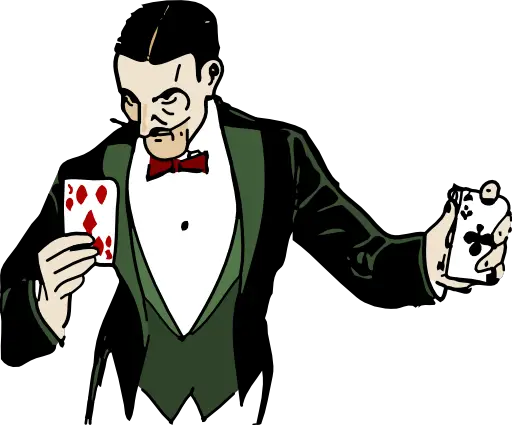Support our educational content for free when you purchase through links on our site. Learn more
What is Mentalism? Unveiling the Secrets of Mind-Bending Illusions [2024] 🤯
Have you ever witnessed a mind-reading act that left you utterly speechless? Perhaps a magician seemed to know your deepest thoughts or predict your future with uncanny accuracy. You might have even questioned if they possessed genuine psychic abilities. But what if we told you that these “supernatural” feats are often the result of a carefully crafted art form known as mentalism?
This comprehensive guide will take you on a journey through the world of mentalism, from its ancient roots to its modern-day mastery. We’ll explore the psychology behind these mind-bending illusions, uncover the secrets of famous mentalists, and even guide you on how to unleash your inner mind reader. By the end, you’ll not only understand the concept of mentalism but also have a newfound appreciation for the power and potential of the human mind.
Quick Answer
Here’s the quick and dirty:
- Mentalism is a performance art that creates the illusion of extraordinary mental abilities. 🧠 It’s not magic, but a clever blend of psychology, observation, and suggestion.
- Mentalists use techniques like cold reading, body language analysis, and misdirection to create their mind-bending effects.
- You can learn the basics of mentalism! ✅ It takes practice, dedication, and a genuine interest in the workings of the human mind.
- 👉 Shop for mentalism books, products, and resources: Amazon | eBay | Mentalism Books & Products
Table of Contents
- Quick Tips and Facts
- The History of Mentalism: From Ancient Mysticism to Modern Stagecraft
- Mentalism vs. Magic: What’s the Difference?
- The Psychology Behind Mentalism: Unveiling the Secrets of the Mind
- Types of Mentalism: A Journey Through the Mind’s Labyrinth
- Famous Mentalists: The Masters of Mind Control
- Learning Mentalism: Unleash Your Inner Mind Reader
- Mentalism in Popular Culture: The Mind-Bending World of Film and TV
- The Ethics of Mentalism: A Balancing Act of Deception and Entertainment
- Conclusion
- Recommended Links
- FAQ
- Reference Links
Quick Tips and Facts
Want to become a mind-blowing mentalist? You’ve come to the right place! But first, let’s test your knowledge. Did you know that the term “mentalism” has roots in both philosophy AND performance art? 🤯 It’s true! What is Mentalism in Psychology? 7 Key Concepts to Unlock the Secrets of Your Mind 2024 🤔
Here at Mind Trick™, we’re all about exploring the incredible power of the human mind – both how it works and how to make it look like it’s bending the rules of reality. 😉
Before we dive deep, let’s lay down some quick-fire facts:
- Mentalism ISN’T about actual mind-reading! ❌ It’s about creating the illusion of it through psychology, suggestion, observation, and a whole lot of cunning.
- Mentalism IS a performance art. ✅ Think stage shows, TV specials, and even close-up illusions that leave audiences astounded.
- Anyone can learn the basics of mentalism! ✅ Yes, even YOU. 😉 It takes practice, dedication, and a genuine interest in the workings of the human mind.
Ready to unlock your inner mentalist? Let’s get started!
The History of Mentalism: From Ancient Mysticism to Modern Stagecraft
Believe it or not, the roots of mentalism are ancient, entwined with mysticism, philosophy, and good old-fashioned trickery.
Ancient Origins: Oracles and Soothsayers
Think back to ancient Greece. Remember the Oracle of Delphi? People flocked to her, believing she could communicate with the gods and predict the future. While we now know these pronouncements were often ambiguous (and sometimes politically motivated!), they highlight humanity’s enduring fascination with those who seem to possess extraordinary mental abilities.
The Rise of Spiritualism: Talking to the Other Side
Fast forward to the 19th century, and Spiritualism takes center stage. Séances, mediums, and spirit cabinets become all the rage. While many practitioners were debunked as frauds, the public’s appetite for connecting with the deceased fueled the development of techniques that would later be adapted by stage magicians and mentalists.
The Birth of Modern Mentalism: From Stage Magic to Psychology
The late 19th and early 20th centuries saw the emergence of mentalism as a distinct form of entertainment. Magicians like Washington Irving Bishop and S.J. Davey incorporated psychological principles into their acts, blurring the lines between illusion and genuine psychic phenomena.
One name stands out as the “father of modern mentalism”: Theodore Annemann. He not only developed groundbreaking techniques but also generously shared his knowledge through books and magazines, inspiring generations of mentalists to come.
Mentalism Today: A Blend of Tradition and Innovation
Today, mentalism continues to evolve, embracing new technologies and psychological insights. From Derren Brown’s mind-bending TV specials to the close-up miracles of Dynamo, mentalism continues to captivate audiences worldwide.
Mentalism vs. Magic: What’s the Difference?
People often use the terms “mentalism” and “magic” interchangeably, but there’s a distinct difference. Think of it this way:
-
Magic is about creating the impossible through physical means – making objects vanish, appear, or transform in ways that defy logic. 🎩 It relies on sleight of hand, illusions, and often elaborate props. Check out our amazing Card Tricks and Levitation articles for a taste of the magical!
-
Mentalism, on the other hand, is about creating the illusion of extraordinary mental abilities. It’s about tapping into the power of the mind – or at least appearing to. Think mind-reading, predicting the future, influencing thoughts, and even moving objects with the power of the mind alone! 🧠 We delve deeper into the psychology behind these tricks in our Magic Psychology section.
Let’s break it down further:
| Feature | Mentalism | Magic |
|---|---|---|
| Focus | Mind Power | Physical Impossibility |
| Tools | Psychology, Suggestion, Observation | Sleight of Hand, Illusions, Props |
| Effect | Awe, Wonder, Belief in the Extraordinary | Surprise, Amazement, Disbelief |
Mentalism, at its core, is about creating a connection with the audience, making them feel like they’re witnessing something truly extraordinary. It’s about tapping into our deepest desires to believe in the impossible and the power of the human mind.
The Psychology Behind Mentalism: Unveiling the Secrets of the Mind
Here’s the real secret sauce of mentalism: it’s not magic, it’s psychology. Mentalists are masters of observation, suggestion, and persuasion. They understand how the human mind works and exploit its quirks and biases to create astonishing illusions.
Here are a few psychological principles that mentalists use:
-
Cold Reading: This is about making general statements that could apply to anyone, then observing the subject’s reactions to narrow down the possibilities. It’s like a verbal game of hot and cold, guiding the mentalist towards specific information.
-
Body Language Analysis: We communicate volumes through our nonverbal cues. Mentalists are experts at reading these subtle signals – a slight shift in posture, a fleeting expression, a change in breathing – to gain insights into a person’s thoughts and feelings.
-
Suggestibility: Humans are surprisingly susceptible to suggestion. Mentalists use subtle techniques, like carefully chosen words and phrases, to influence a person’s thoughts and actions without them even realizing it.
-
Misdirection: Just like magicians, mentalists use misdirection to divert the audience’s attention away from the method and towards the effect. By focusing your attention on one thing, they can do something else right under your nose without you noticing!
-
Priming: This involves subtly exposing someone to a stimulus to influence their later responses. For example, a mentalist might casually mention a certain word or image earlier in the act, making it more likely that the subject will think of it later.
By combining these techniques with showmanship and charisma, mentalists create the illusion of genuine psychic abilities. They tap into our desire to believe in the extraordinary, leaving us wondering: “How did they DO that?”
Types of Mentalism: A Journey Through the Mind’s Labyrinth
Mentalism is a diverse art form, encompassing a wide range of effects and techniques. Here are some of the most common types of mentalism:
-
Mind Reading: This is the classic mentalism effect – appearing to know what someone is thinking. It can range from simple card guesses to seemingly impossible feats of knowing a person’s deepest secrets.
-
Predictions: Mentalists often perform feats of precognition, predicting future events or outcomes. This might involve sealed envelopes, locked boxes, or even predictions made publicly in advance.
-
Psychokinesis (PK): This involves influencing the physical world with the power of the mind – bending spoons, moving objects at a distance, or even levitating.
-
Telepathy: This refers to communicating directly with another person’s mind, sending and receiving thoughts without any spoken words or physical signals.
-
Clairvoyance: Mentalists claiming clairvoyance appear to possess knowledge of hidden objects, events, or information that they couldn’t have acquired through normal means.
It’s important to remember that these are all illusions, carefully crafted using a combination of psychology, suggestion, and showmanship. Mentalists are entertainers, not psychics, and their goal is to create a sense of wonder and astonishment, not to claim genuine supernatural abilities.
Famous Mentalists: The Masters of Mind Control
Over the years, numerous talented individuals have graced the world with their mind-boggling mentalism acts. These masters of illusion have left audiences speechless, questioning the very fabric of reality. Let’s delve into the lives and legacies of some of these iconic figures:
-
Theodore Annemann: Often hailed as the “father of modern mentalism,” Annemann revolutionized the field with his innovative techniques and prolific writings. He emphasized the importance of psychology, suggestion, and meticulous planning in creating convincing mentalism effects.
-
Dariel Fitzkee: An author and magician who delved deep into the methods behind mentalism. His renowned book, “The Trick Brain,” remains a seminal work, exploring the psychological principles that make mentalism so effective.
-
Kreskin: This enigmatic figure rose to fame in the 1970s with his televised feats of mind reading and prediction. Kreskin often incorporated a “challenge” element into his act, inviting audiences to test his abilities, further blurring the lines between entertainment and the paranormal.
-
Derren Brown: A modern master of mentalism, Brown is known for his sophisticated and often controversial TV specials. He seamlessly blends psychology, suggestion, and illusion to create truly mind-bending experiences that leave a lasting impact. His work often explores the darker side of human nature and the power of belief.
-
David Berglas: A highly influential British mentalist known for his impromptu, seemingly impossible feats of mind reading and influence. Berglas’s approach relies heavily on subtle psychological techniques and an uncanny ability to connect with his audience on a personal level.
These are just a few of the many talented mentalists who have captivated audiences worldwide. Their work continues to inspire and amaze, reminding us of the incredible power and potential of the human mind.
Learning Mentalism: Unleash Your Inner Mind Reader
Have these incredible tales of mentalism sparked a desire within you to explore the hidden depths of the human mind? Fear not, aspiring mentalist, for the journey to unlocking your inner mind reader starts now!
1. Start with the Basics: Psychology and Observation
Mentalism is more than just tricks; it’s about understanding how people think and behave. Dive into the world of psychology, focusing on:
- Body Language: Learn to decipher the subtle cues people reveal through their posture, gestures, and facial expressions.
- Cognitive Biases: Explore the predictable errors in thinking that influence our perceptions and decision-making.
- Social Engineering: Discover how to manipulate situations and influence people’s actions through subtle psychological tactics.
2. Master the Art of Suggestion:
Words are your weapons, shaping perceptions and planting ideas. Hone your skills in:
- Hypnotic Language Patterns: Learn to structure your language in a way that bypasses critical thinking and speaks directly to the subconscious mind.
- Neuro-Linguistic Programming (NLP): Explore the powerful techniques for understanding and influencing human behavior through language and communication.
- Cold Reading: Practice crafting general statements that resonate with a wide range of people, then refine your approach based on their reactions.
3. Build Your Mentalism Repertoire:
Start with simple tricks and techniques, gradually working your way up to more complex illusions. Some great starting points include:
- Card Forces: Learn to subtly influence a participant’s card selection, making it seem like you’ve read their mind. Check out our Card Tricks section for inspiration!
- Book Tests: Develop a system for predicting words or phrases chosen from a book, creating the illusion of clairvoyance.
- Psychological Illusions: Explore classic mentalism effects like the “Grey Elephant in Denmark” or “Orange Kangaroo from Australia” to understand how suggestion and misdirection can create powerful illusions.
4. Practice, Practice, Practice!
Like any skill, mentalism requires dedication and consistent effort. Practice your techniques in front of a mirror, then with friends and family. As you gain confidence, consider joining a local magic club or seeking out a mentor to further develop your skills.
5. Resources for Aspiring Mentalists:
- Books: “13 Steps to Mentalism” by Corinda, “Practical Mental Effects” by Annemann
- Online Courses: Masterclass, Udemy, Ellusionist
- Magic Shops: Your local magic shop can be a great resource for books, props, and advice.
Remember, the journey of a thousand miles begins with a single step. Embrace the challenge, nurture your curiosity, and never stop exploring the boundless potential of the human mind.
Mentalism in Popular Culture: The Mind-Bending World of Film and TV
Mentalism, with its air of mystery and intrigue, has long been a staple of popular culture, captivating audiences through film, television, and literature.
The Allure of the Unknown:
From classic films like “The Illusionist” and “The Prestige” to mind-bending TV shows like “The Mentalist” and “Psych,” these portrayals often blur the lines between fiction and reality, leaving viewers questioning the limits of human potential.
Here’s a glimpse into the captivating world of mentalism in popular culture:
-
Movies:
- The Illusionist (2006): Set in Vienna at the turn of the century, this visually stunning film follows a magician, Eisenheim, as he uses his powers to win back his childhood love from a cruel prince. The film masterfully weaves together romance, mystery, and the allure of the impossible.
- The Prestige (2006): This gripping thriller explores the intense rivalry between two magicians, Robert Angier and Alfred Borden, as they push the boundaries of their craft, leading to dark consequences. The film delves into the themes of obsession, sacrifice, and the lengths to which one might go to achieve greatness.
- Now You See Me (2013): This action-packed heist film features a group of illusionists known as “The Four Horsemen” who use their skills to pull off elaborate heists while exposing corruption and sharing their wealth with the audience. The film is a visual treat, filled with twists, turns, and mind-boggling magic tricks.
-
TV Shows:
- The Mentalist (2008-2015): This popular crime procedural follows Patrick Jane, a former psychic who uses his keen powers of observation and psychological manipulation to help solve crimes.
- Psych (2006-2014): This quirky and comedic detective series features Shawn Spencer, a hyper-observant consultant who pretends to be psychic to help the Santa Barbara Police Department solve crimes.
- Lie to Me (2009-2011): Inspired by the work of Dr. Paul Ekman, this crime drama centers around a team of deception experts who analyze microexpressions and body language to determine if someone is lying.
These are just a few examples of how mentalism has infiltrated our collective consciousness, shaping our perceptions of what’s possible and fueling our fascination with the unknown.
The Ethics of Mentalism: A Balancing Act of Deception and Entertainment
Mentalism, like any art form that involves deception, walks a fine ethical line. While most mentalists are entertainers at heart, using their skills to create a sense of wonder and amusement, there’s always the potential for misuse.
Ethical Considerations:
- Respect for the Audience: Mentalists should treat their audiences with respect, avoiding manipulation or exploitation. It’s crucial to be transparent about the nature of the performance, emphasizing that it’s entertainment, not genuine psychic abilities.
- Avoiding Harm: Mentalists should be mindful of the potential psychological impact of their performances, ensuring that their acts don’t cause undue stress, anxiety, or emotional distress.
- Honesty in Advertising: It’s unethical to present oneself as possessing genuine psychic powers or to make claims that cannot be substantiated. Mentalism should be promoted as a form of entertainment, not a supernatural phenomenon.
- Protecting the Craft: Mentalists have a responsibility to protect the secrets of their art, ensuring that methods and techniques are not revealed to the general public. This helps to maintain the sense of mystery and wonder that makes mentalism so captivating.
The Importance of Transparency:
Many mentalists choose to address the ethical considerations of their craft directly, openly acknowledging that their performances are based on skill and deception, not supernatural abilities. This transparency can enhance the audience’s enjoyment, allowing them to appreciate the artistry and ingenuity behind the illusions without feeling misled.
Mentalism for Good:
Some mentalists use their skills for purposes beyond entertainment, such as:
- Promoting Critical Thinking: Mentalism can be a powerful tool for teaching people about the fallibility of perception and the importance of critical thinking.
- Fundraising for Charity: Mentalism performances can be used to raise money for worthy causes, combining entertainment with philanthropy.
- Therapeutic Applications: Some mentalists explore the potential therapeutic benefits of their craft, using techniques like suggestion and hypnosis to help people overcome phobias, manage stress, or break negative habits.
Ultimately, the ethics of mentalism come down to responsibility and intent. When practiced with integrity and respect for the audience, mentalism can be a powerful form of entertainment, sparking wonder, curiosity, and a deeper appreciation for the complexities of the human mind.
Conclusion
Mentalism isn’t about magic, it’s about the magic of the mind! It’s about understanding how we perceive the world, how our thoughts and behaviors are influenced, and how to create the illusion of extraordinary mental abilities.
We’ve explored the history of mentalism, from ancient oracles to modern stage performers, and uncovered the psychological principles that make it so effective. We’ve even delved into the ethics of mentalism, recognizing the importance of transparency, respect for the audience, and the potential for using these skills for good.
Remember, mentalism is an art form that requires practice, dedication, and a genuine interest in the human mind. If you’re curious about exploring this fascinating world, there are endless resources available to help you unlock your inner mind reader.
So, go forth, aspiring mentalist, and embrace the power of the mind! 😉
Recommended Links
👉 Shop for Mentalism Books:
- “13 Steps to Mentalism” by Corinda: Amazon | eBay
- “Practical Mental Effects” by Theodore Annemann: Amazon | eBay
👉 Shop for Mentalism Products:
FAQ
What is the theory of mentalism?
The theory of mentalism in psychology suggests that language acquisition is innate, meaning humans are born with a predisposition for learning language. This theory, proposed by Noam Chomsky, posits that children are equipped with a Language Acquisition Device (LAD), a brain system that enables them to quickly and effortlessly acquire their native language.
What is the Language Acquisition Device (LAD)?
The LAD is a hypothetical mental faculty that contains the universal principles of human language, known as Universal Grammar (UG). UG represents the innate knowledge of linguistic rules, constraints, and principles that are common to all languages. This innate knowledge allows children to learn language despite limited exposure to it.
What is mentalism and how does it work?
Mentalism is a performance art that creates the illusion of extraordinary mental abilities, like mind reading, predicting the future, or influencing thoughts. It’s not about genuine psychic powers, but rather about using psychological techniques, observation, and skillful manipulation to create astonishing effects.
How does mentalism work?
Mentalists employ various psychological principles to achieve their illusions, including:
- Cold Reading: Making general statements that could apply to anyone, then observing the subject’s reactions to narrow down the possibilities.
- Body Language Analysis: Reading subtle nonverbal cues to gain insights into a person’s thoughts and feelings.
- Suggestibility: Using carefully chosen words and phrases to influence a person’s thoughts and actions without them realizing it.
- Misdirection: Diverting the audience’s attention away from the method and towards the effect.
- Priming: Subtly exposing someone to a stimulus to influence their later responses.
Read more about “Is Mentalism Real? Unmasking the Mind Readers: 10 Secrets Revealed … 🤯”
What is the meaning of mentalism?
The meaning of mentalism depends on the context. In philosophy, mentalism refers to the view that mental phenomena, like thinking and feeling, are fundamental and cannot be reduced to physical processes. In the context of performance art, mentalism refers to the practice of creating the illusion of extraordinary mental abilities through psychological techniques and skillful deception.
Read more about “The Mind-Bending Truth About Mentalism in ABA … 🧠”
What is the logic behind mentalism?
The logic behind mentalism lies in understanding the psychology of perception and behavior. Mentalists exploit the quirks of the human mind, including:
- Cognitive Biases: Predictable errors in thinking that influence our perceptions and decision-making.
- Social Norms: Expectations and unwritten rules that guide our behavior in social situations.
- The Power of Suggestion: The tendency for our minds to accept and believe what we are told, especially when presented in a convincing manner.
By understanding these psychological principles, mentalists can manipulate situations, influence perceptions, and create the illusion of extraordinary mental abilities.
Read more about “Mentalism in Psychology: Unmasking the Mind’s Tricks 🧠 …”
Reference Links
- “The Trick Brain” by Dariel Fitzkee: Amazon | eBay
- “04. Mentalism.pptx – SlideShare”: SlideShare | Related Sites
- “Dynamo”: Dynamo’s Official Website
- “The Mentalist”: CBS | IMDb
- “Psych”: USA Network | IMDb
- “Lie to Me”: Fox | IMDb







